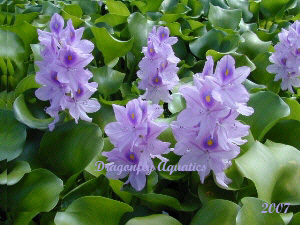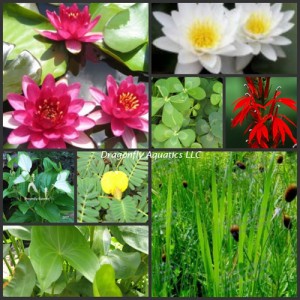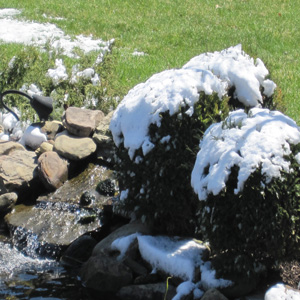Well our busy season is upon us and we're excited about the plants we're sending. We have several new pond plants this year. A couple new lotus, waterlilies and bog plants. Check them out at our store, www.dragonflyaquatics.com.
I often get questions about whether to use water lettuce or water hyacinths as floaters in the pond. They both basically serve the same purpose.
Water lettuce (Pistia stratiotes) has light green spongy leaves that looked as if they have veins running through them. The leaves are approximately 1-5" wide. The leaves are covered with tiny hairs and occasionally tiny white flowers appear in the center. Water lettuce prefers partial shade during the hotest part of the day and once the water warms up will multiply quickly. Their dangling roots provide a place for fish to hid. Water lettuce can be very aggressive and can deplete the oxygen in the water if you let it take over your entire pond. So its a good idea to take out some if they start to multiply rapidly. Water temperature should be 60 - 65 degrees before placing water lettuce in your pond as it will turn the leaves white and they will die.
Water Hyacinth - Eichornia crassipes) A floating plant that is a fast grower and beneficial for water filtration. They have bright green rounded leaves and will get a purple flower on them throughout the season. Water hyacinth have dangling roots that help filter and clean the water. We have alot of customers who ordered water hyacinths first in the spring to provide shade immediately to help prevent growth of algae. It takes other plants such as water lilies longer to produce their leaves to help provide the coverage needed. When you first receive your water hyacinths you want to put them in shade for a day before adding them to your pond in direct sun or the leaves will turn brown. They need to soak water up in their leaves. Again make sure your water temperatures are 60 - 65 degrees before placing in your pond.
New this year for Dragonfly Aquatics and will be added to our store.
A floating, rootless aquatic fern that floats just below the water surface producing a pair of floating or emergent leaves that are green in color and oblong in shape. They have a third leaf that is brown in color and dangles underwater sometimes mistaken as a root but helps to stabilize the plant. The plant itself has no roots but tiny white hairs beneath the leaves.
HARDY LOTUS
As the lotus leaves begin to turn brown, the lotus is beginning to go dormant for the winter. Do not cut off the leaves; allow them to die back naturally. After they die back at this point, it is safe to cut them off above the water line. Its important to leave a portion of the stem above the water. You do not want water getting down the hollow green stem and having it get into the air channels of the tuber, if this happens you risk drowning the tuber and cause it to rot. Make sure the potted lotus is below the ice. Allowing the tuber to freeze will kill the plant.

Floating plants such as Water Hyacinth and Water Lettuce are considered tropical and will not survive temperatures below freezing. After the first hard frost, remove from the pond to prevent them from decaying and adding unwanted debris to the pond.
 We had highs in the low to mid 80's the last couple of days here in Ohio. One week snow, the next unseasonably warm. Don't want to get too used to it though, next week we will be back to the normal spring time temperatures. Normal here this time of year is mid 50's to mid 60's. Nothing like a few warm days though to get people out working on their ponds. The weather has been on the unusual side. One week snow, the next record breaking high temperatures. It makes it very difficult to know when to ship plants. Many of the plants we sell are cold sensitive and trying to second guess Mother Nature is sometimes impossible! We have customers in the Pacific Northwest that are still freezing, the time has passed when we usually can start to send their plants. Old Man Winter just isn't moving out of that part of the country yet. Hopefully, things will start to warm up for them in the next week or two. And for us in Ohio, we can only hope the milder temperatures will continue. We just want to remind everyone, just because you are having warm temperatures today, does not mean it is safe to put plants out before your last frost date. It has been such a long winter, I know everyone is a little impatient....I am too! But, always remember, Mother Nature likes to throw curve balls at us! Just when we think it is safe to put plants out, along comes a freeze warning!
We had highs in the low to mid 80's the last couple of days here in Ohio. One week snow, the next unseasonably warm. Don't want to get too used to it though, next week we will be back to the normal spring time temperatures. Normal here this time of year is mid 50's to mid 60's. Nothing like a few warm days though to get people out working on their ponds. The weather has been on the unusual side. One week snow, the next record breaking high temperatures. It makes it very difficult to know when to ship plants. Many of the plants we sell are cold sensitive and trying to second guess Mother Nature is sometimes impossible! We have customers in the Pacific Northwest that are still freezing, the time has passed when we usually can start to send their plants. Old Man Winter just isn't moving out of that part of the country yet. Hopefully, things will start to warm up for them in the next week or two. And for us in Ohio, we can only hope the milder temperatures will continue. We just want to remind everyone, just because you are having warm temperatures today, does not mean it is safe to put plants out before your last frost date. It has been such a long winter, I know everyone is a little impatient....I am too! But, always remember, Mother Nature likes to throw curve balls at us! Just when we think it is safe to put plants out, along comes a freeze warning!
 This is what some of us in the North woke up to this morning, and this was after some of it had melted. What happened to those 50 and 60 degree days??? Hopefully they will be back again soon. How can we get started cleaning our ponds and thinking putting those new plants in if the water is too cold to put our hand in it. And what about those fish and frogs???? They are hiding again.
This is what some of us in the North woke up to this morning, and this was after some of it had melted. What happened to those 50 and 60 degree days??? Hopefully they will be back again soon. How can we get started cleaning our ponds and thinking putting those new plants in if the water is too cold to put our hand in it. And what about those fish and frogs???? They are hiding again.
Whenever this happens, those of us who wanted our plants shipped thinking its finally warm wonder, now what do I do with them. Make sure you protect them by bringing them indoors until it warms up. Remember most of the plants have been indoors in a greenhouse environment and shiver even when the temps are in the 60s. But we need to make sure the water temperature have stabilized to 65 degrees before we put those floating plants out.
The floating water plants in your pond need to have the water temperature reach 65 degrees. They will show signs of yellowing leaves and black spots on their leaves if left in water temps below that. The water lettuce will wilt and turn white if too cold. We tend to get anxious in the spring and sometimes put floaters in before the water is warm enough. Even the lotus and waterlilies need the warmer weather to start growing. But at least those were outside all winter and were pulled to ship out.
Hopefully, like last year, this is a short spell and in a couple weeks things will turn around and we can once again start looking forward to enjoying our ponds.
There are five different types of plants that you will want to add to your pond to provide beauty and help you achieve an ecological balance in your water garden.
Submerged plants such as Anacharis, Vallisneria, Cabomba, Hornwort and Red Ludwigia remove nutrients from the water so algae can’t thrive. Submerged plants do not need soil. Just plant them in one-gallon pots or plant baskets filled with pea gravel and place them in the bottom of your pond. Or purchase plant anchors with your plant order, and simply wrap the weights around the bunch of plants and they will sink to the bottom of the pond.
Water Hyacinth, Water Lettuce, Frog Bit, Parrot’s Feather and Azolla are all members of the floating plant family. Floating plants are very useful in keeping the pond water clean and clear. These are simple plants that free-float and do not need to be potted. You simply toss them into the water garden where they are extremely beneficial to the pond. Floating plants shade the surface and with their roots dangling in the water they pull nutrients from the water essentially starving the algae. They tend to be quite prolific and provide hiding places for baby fish and other water garden inhabitants.
Otherwise known as water lilies, they grow in pots placed 12 to 36 inches deep and have foliage and flowers that bloom on top of the water’s surface. Water lilies provide shade for the fish and add coverage to the water’s surface. Water lilies are available in many different colors and sizes.
Lotus are also considered a hardy water plant that can also be planted deep in your pond and its flowers and leaves will help provide shade and coverage.
Plants such as the hardy canna (Thalia dealbata) grow in mud or 8 to 12 inches deep in the water. Arrange them on platform shelves on the edge of your pond to conceal the water garden’s artificial edges. Plant bog and marginal plants in plastic pots, then place the pot under the water and let the plants grow in the open air. When the plants are young, use care and gradually lower them deeper as the plant matures.
Bog Plants and Marginal Plants
Marginal and bog plants grow in damp soil just outside a pond. They are good transition plants between land and water. Some tolerate completely waterlogged ground and others will not tolerate more than moist soil, check each plant’s requirements carefully.